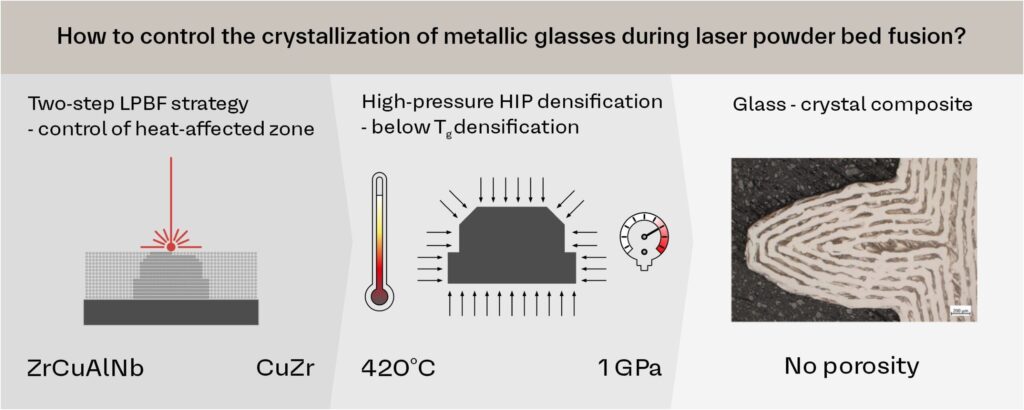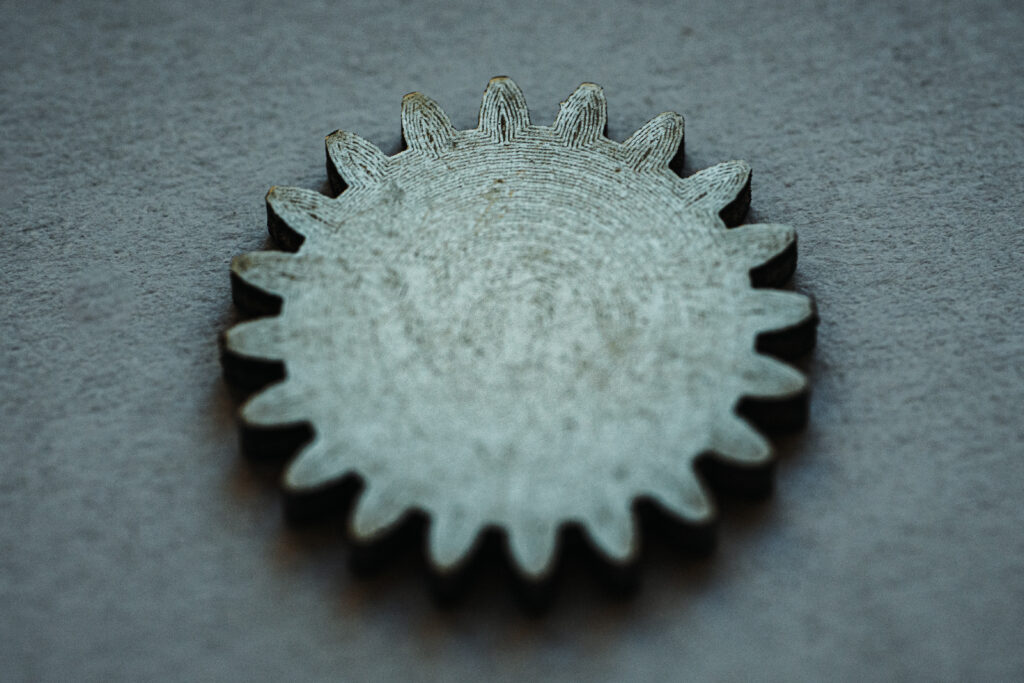Metallic glasses (MGs), or amorphous metals, are materials with a disordered atomic structure, unlike the ordered crystal lattice found in traditional metals. This unique structure provides them with superior strength, hardness, elasticity, and corrosion resistance compared to crystalline metals. Their unusual properties make them suitable for diverse applications, from electronics to aerospace, though their production requires specialized rapid cooling and manufacturing techniques. Additive manufacturing (AM) is uniquely suited to using materials like metallic glasses due to its ability to rapidly cool molten material, essential for maintaining the amorphous, non-crystalline structure of these glasses, while also allowing for the precise fabrication of complex shapes and geometries that are often challenging to achieve with traditional manufacturing methods.
Lukasz Zrodowski, a pioneering inventor in the field of metal AM, specializes in MG printing, ultrasonic atomization technology, and automated support removal. He currently leads a dynamic team of approximately 17 engineers and researchers at his company AMAZEMET and Warsaw University of Technology. In a recent interview with 3DPrint.com, Lukasz shared insights into their groundbreaking work on laser powder bed fusion (LPBF) of metallic glasses and their composites, as well as material-specific design for AM (DfAM).
3DPrint.com: Your team’s recent work in LPBF of MGs and their composites has captured the attention of the scientific community, especially in the fields of material science and manufacturing. Could you provide our readers with a concise overview of these findings?
Zrodowski: Our research has primarily focused on applying LPBF to MGs and their composites. Metallic glasses, discovered in the 1960s, are known for their distinct soft magnetic properties. However, their potential as structural materials has been somewhat limited due to challenges such as poor ductility and complex manufacturing processes.
In our study, we introduced a strategy to produce highly oriented crystalline-amorphous composites using the LPBF process. By employing a novel two-stage melting approach and ultra-high-pressure hot isostatic pressing (HIP) on specific amorphous alloys like AMZ4 (designed by Professor Ralf Busch) and equiatomic CuZr, atomized by AMAZEMET’s ultrasonic atomization technology, we achieved significant results. By adjusting the laser parameters, we can produce parts made entirely of amorphous material. Furthermore, we can create composites with a geometry-specific microstructural design based on a laminate amorphous-crystalline structure.
Our research has opened up new possibilities for non-equilibrium phase distribution design, offering the potential to design microstructures on parts with LPBF and other powder bed fusion technologies. We believe this approach can revolutionize product design and manufacturing, especially in the area of bulk metallic glasses, which we anticipate will see increased commercialization in the future.
3DPrint.com: LPBF is an Additive Manufacturing technique that has the potential to revolutionize product design and manufacturing. You have also applied the concept of DfAM to MGs and their composites. Can you explain the challenges associated with traditional manufacturing methods for MGs and how you have overcome these challenges using DfAM in conjunction with LPBF?
Zrodowski: MGs have consistently demonstrated promising mechanical and chemical properties. However, their use as structural materials has been limited due to inherent challenges, such as poor ductility and complex traditional manufacturing processes. For example, injection molding of MGs requires high-purity feedstocks and expensive tooling. Additionally, while numerous MG compositions have been discovered, only a few possess the ideal combination of glass-forming ability, toughness, and processability to be economically viable.
Enter LPBF, an Additive Manufacturing technique. With LPBF, we have managed to overcome some traditional manufacturing challenges of MGs, including poor machinability and limitations on casting diameter. However, LPBF also presents its own challenges when processing MGs. Due to the metastable nature of MGs, optimizing LPBF often involves balancing the control of porosity with the crystalline phase content. A high energy density in the LPBF process can reduce porosity but may also accelerate devitrification in the heat-affected zone (HAZ), typically considered a material defect.
Our approach, influenced by the principles of DfAM, involves a two-stage melting strategy. This method separates the interaction between the laser and the powder from the final densification and microstructural design phases. Consequently, we can produce nearly dense MGs and their composites while avoiding excessive heat accumulation. This technique not only addresses the challenges of traditional MG manufacturing but also opens the door for innovative MG applications across various industries.
Controlling process of the Metallic Glasses crystallization during LPBF
3DPrint.com: Can you share what materials were used in your study and findings? Additionally, are there any other materials that you foresee as potentially viable for use on a commercial scale?
Zrodowski: Our research primarily focused on a benchmark alloy in Bulk Metallic Glasses (BMG) research, AMZ4 (Zr59.3Cu28.8Al10.4Nb1.5), developed by Ralf Busch. In 2017, AMZ4 was one of the few glass-forming alloys available in spherical powder form. As a proof of concept, we applied our printing strategies to equiatomic CuZr amorphous alloys, atomized by ultrasonic atomization. However, it’s important to note that these alloys were not originally developed for LPBF, and further research is needed on alloys with specific MG compositions designed for LPBF.
I am optimistic that the ultrasonic atomizer developed at AMAZEMET – the rePOWDER – will accelerate the development of novel, promising alloys, like the recently atomized Ti-S BMG. The preliminary results, which we recently presented at the Alloys for Additive Manufacturing Symposium (AAMS) in Madrid, were very encouraging. Researchers from the University of Duisburg Essen showcased the potential of these alloys in forming dense and amorphous parts, marking a significant step forward in this field.
Metallic Glass component
3DPrint.com: What challenges are you currently facing with the DfAM of MGs using LPBF, and how do you anticipate these could be addressed in the near future, especially considering that this field is still evolving?
Zrodowski: Printing MGs with LPBF using our approach necessitates sophisticated LPBF scanning strategies, which might exceed the capabilities of some standard industrial software. Implementing these strategies for simple geometries can be manually achieved with a few software tricks. However, complex geometries demand the development of automated laser scanning strategies, particularly for composite materials. To facilitate this process and promote the industrialization of this technology, new LPBF models are required. These models should account for non-equilibrium phase changes and crystallization from amorphous phases.
In the printing of MGs, effectively managing heat input to the material is crucial. As a result, active process controls, such as thermal cameras or pyrometers integrated with suitable software, are being introduced to printers. These controls could provide solutions to current challenges in printing complex shapes from MGs, like local devitrification due to heat accumulation or cracking caused by stress concentration.
Metallic Glass Gear
3DPrint.com: Could you briefly outline the experimental steps you took to arrive at your findings, without going into too much detail?
Zrodowski: Our approach involved a step-by-step process:
-
Material Selection: Initially, we utilized the AMZ4 alloy for its commercial availability, excellent glass-forming ability, and other favorable properties.
-
Laser Melting: We used the Realizer SLM 50 machine for processing the materials. The optimization of the LPBF process was divided into three phases: Creation of single tracks in both bulk material and powder, walidation of the scanning strategy, and fine-tuning of laser parameters.
-
Post-Processing: Following the laser melting process, we achieved final densification using Hot Isostatic Pressing (HIP).
-
Thermal Analysis: Differential Scanning Calorimetry (DSC) was employed to quantify the glassy phase content.
-
Microstructure Characterization: Preliminary characterization was conducted using light microscopy. Electron microscopy, including SEM and STEM, was utilized to identify crystallites in the samples. Micro-CT examinations were performed to assess the internal porosity of the samples in detail.
-
Mechanical Tests: We conducted 4-point bending tests on the specimens to evaluate their mechanical properties. Wear resistance was also assessed using a pin-on-disk test.
-
Nanoindentation: This was performed to map the hardness and elastic modulus of the composite specimen.
-
Application to CuZr Material: As a proof of concept, the same printing strategies were applied to CuZr material.
In parallel, I have commercialized a patent on printing MG composites and subsequently founded a company that manufactures ultrasonic atomizers, which now employs over 60 people.
3DPrint.com: Finally, what does the future hold for DfAM of MGs, and what are the potential areas of application for this technology?
Zrodowski: Limitations with current MG alloys printed with LPBF, like the high brittleness of the crystalline phase, inhibit the full potential of using DfAM to design composite parts with both optimized shape and microstructure. When specialized alloys are developed, new applications will emerge, like implants with material properties like stiffness tailored across a single part by both shape (lattice structures) and microstructure. Another example would be rotors of electric motors, where different coercivities of amorphous and crystalline phases could allow for more efficient rotor designs.
The concept of DfAM with composite microstructure can be explored further with other non-glass forming alloys where the concept of in-situ localized heat treatment can add another dimension – the microstructure design to additive manufacturing.
The work of Lukasz Zrodowski and his team at AMAZEMET, in collaboration with the Warsaw University of Technology, represents a significant leap forward in the field of AM and MGs. Their innovative use of LPBF to create highly oriented crystalline-amorphous composites showcases the potential to revolutionize material science and manufacturing. By addressing the challenges associated with traditional manufacturing of metallic glasses and employing a unique two-stage melting strategy, they have not only enhanced the viability of these materials but also opened up new avenues for their application in various industries. The future of DfAM with metallic glasses looks promising, with potential applications ranging from medical implants to more efficient motor designs. This pioneering work paves the way for further exploration and commercialization of MG composites, marking a notable advancement in both the science and practical application of these fascinating materials.
Subscribe to Our Email Newsletter
Stay up-to-date on all the latest news from the 3D printing industry and receive information and offers from third party vendors.
Print Services
Upload your 3D Models and get them printed quickly and efficiently.
You May Also Like
Heating Up: 3D Systems’ Scott Green Discusses 3D Printing’s Potential in the Data Center Industry
The relentless rise of NVIDIA, the steadily increasing pledges of major private and public investments in national infrastructure projects around the world, and the general cultural obsession with AI have...
Formlabs Teams Up with DMG MORI in Japan
In late June, Nick Graham, Chief Revenue Officer at Formlabs, announced on LinkedIn that the company had partnered with DMG MORI, one of the world’s leading machine tool companies, to...
EOS in India: AM’s Rising Star
EOS is doubling down on India. With a growing base of aerospace startups, new government policies, and a massive engineering workforce, India is quickly becoming one of the most important...
3D Printing News Briefs, June 25, 2025: R&D Materials, 3D Printed Veneers, & More
In today’s 3D Printing News Briefs, 3DXTECH has launched a program that gives customers early access to experimental materials, and the first Lithoz CeraFab Multi 2M30 in the Czech Republic...







































